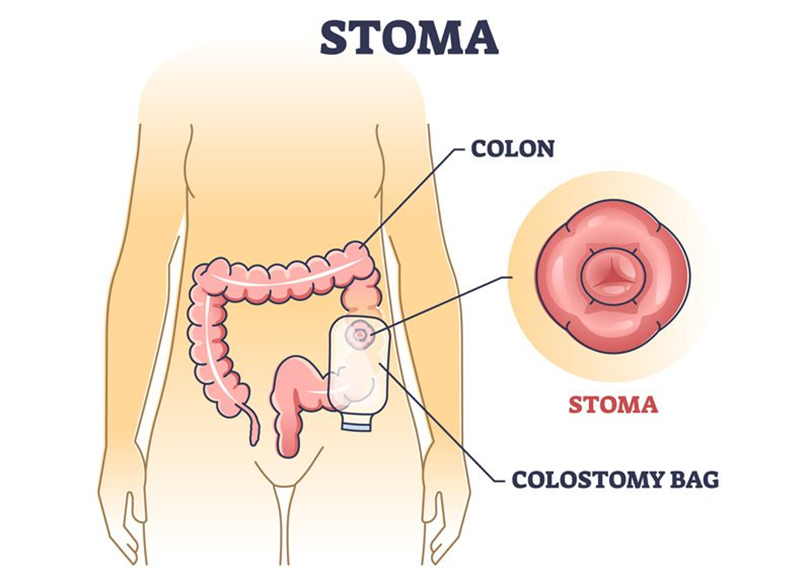A nurse in a PACU is assessing a client who has a newly created colostomy. Which of the following findings should the nurse report to the provider?
Rosebud-like stoma orifice
Stoma oozing red drainage
Shiny, moist stoma
Purplish-colored stoma
None
None
The Correct Answer is D
Choice A: Rosebud-like Stoma Orifice
A rosebud-like stoma orifice is typically a normal appearance for a new stoma. The stoma should be moist, pink to red in color, and protrude slightly from the abdomen, resembling a rosebud. This appearance indicates good blood flow and proper healing. Therefore, this finding does not usually require immediate reporting to the provider.
Choice B: Stoma Oozing Red Drainage
While some minor bleeding or oozing can be normal immediately after surgery, persistent or significant red drainage from the stoma could indicate a complication such as infection or trauma to the stoma site. This finding should be monitored closely, but it is not as immediately concerning as a purplish-colored stoma, which indicates a more severe issue.
Choice C: Shiny, Moist Stoma
A shiny, moist stoma is a sign of a healthy stoma. The stoma should always appear moist and slightly shiny due to the mucus produced by the intestinal lining. This finding is normal and does not require reporting to the provider.
Choice D: Purplish-Colored Stoma
A purplish-colored stoma is an immediate concern and should be reported to the provider. This discoloration can indicate compromised blood flow to the stoma, which can lead to tissue necrosis if not addressed promptly. Ensuring adequate blood supply is crucial for the stoma’s viability and the patient’s overall health. Immediate medical intervention is necessary to prevent further complications.

Nursing Test Bank
Naxlex Comprehensive Predictor Exams
Related Questions
Correct Answer is D
Explanation
Choice A: Rosebud-like Stoma Orifice
A rosebud-like stoma orifice is typically a normal appearance for a new stoma. The stoma should be moist, pink to red in color, and protrude slightly from the abdomen, resembling a rosebud. This appearance indicates good blood flow and proper healing. Therefore, this finding does not usually require immediate reporting to the provider.
Choice B: Stoma Oozing Red Drainage
While some minor bleeding or oozing can be normal immediately after surgery, persistent or significant red drainage from the stoma could indicate a complication such as infection or trauma to the stoma site. This finding should be monitored closely, but it is not as immediately concerning as a purplish-colored stoma, which indicates a more severe issue.
Choice C: Shiny, Moist Stoma
A shiny, moist stoma is a sign of a healthy stoma. The stoma should always appear moist and slightly shiny due to the mucus produced by the intestinal lining. This finding is normal and does not require reporting to the provider.
Choice D: Purplish-Colored Stoma
A purplish-colored stoma is an immediate concern and should be reported to the provider. This discoloration can indicate compromised blood flow to the stoma, which can lead to tissue necrosis if not addressed promptly. Ensuring adequate blood supply is crucial for the stoma’s viability and the patient’s overall health. Immediate medical intervention is necessary to prevent further complications.

Correct Answer is C
Explanation
Choice A Reason:
Administering levetiracetam intravenously is not the first intervention. While levetiracetam is an antiepileptic drug used to control seizures, it is not the first-line treatment for an ongoing seizure, especially one lasting as long as 15 minutes. The priority in this situation is to stop the seizure activity immediately to prevent further complications, such as neuronal damage or status epilepticus. Levetiracetam may be used later for maintenance therapy, but it is not the initial emergency intervention.
Choice B Reason:
Obtaining a STAT electroencephalogram (EEG) is important for diagnosing and understanding the type of seizure activity, but it is not the first intervention. The immediate priority is to stop the seizure. An EEG can be performed after the seizure has been controlled to assess brain activity and guide further treatment. Delaying the administration of an anticonvulsant to perform an EEG could result in prolonged seizure activity and increased risk of complications.
Choice C Reason:
Administering lorazepam intravenously is the most appropriate first intervention. Lorazepam is a benzodiazepine that acts quickly to stop seizure activity. It is the drug of choice for treating status epilepticus and prolonged seizures because of its rapid onset and effectiveness. Administering lorazepam helps to quickly terminate the seizure, reducing the risk of complications and stabilizing the patient for further evaluation and treatment.
Choice D Reason:
Obtaining a STAT 12-lead electrocardiogram (ECG) is not the first intervention. While an ECG can provide valuable information about the patient’s cardiac status, it does not address the immediate need to stop the seizure. The priority is to administer an anticonvulsant to terminate the seizure. Once the seizure is controlled, an ECG can be performed to assess any potential cardiac issues, especially if the patient has a history of cardiac problems or if the seizure was triggered by a cardiac event.
Whether you are a student looking to ace your exams or a practicing nurse seeking to enhance your expertise , our nursing education contents will empower you with the confidence and competence to make a difference in the lives of patients and become a respected leader in the healthcare field.
Visit Naxlex, invest in your future and unlock endless possibilities with our unparalleled nursing education contents today
Report Wrong Answer on the Current Question
Do you disagree with the answer? If yes, what is your expected answer? Explain.
Kindly be descriptive with the issue you are facing.
